- About
- Topics
- Story
- In-Depth
- Picks
- Opinion
- News
- Donate
- Signup for our newsletterOur Editors' Best Picks.Send
Read, Debate: Engage.
| April 15, 2025 | |
|---|---|
| topic: | Overfishing |
| tags: | #overfishing, #illegal fishing |
| located: | Indonesia, China, Thailand, Japan, Brazil, Mauritania, Mexico, Hong Kong |
| by: | Garry Lotulung |
This photo essay contains graphic images that some readers may find disturbing.
Tanjung Luar is one of the largest shark markets in Indonesia and Southeast Asia, located in a fishing village facing the Indian Ocean in East Lombok, West Nusa Tenggara Province. The majority of the population lives in coastal areas and relies on the marine ecosystem for their livelihoods and food security.
Sharks play an important role in the ecosystem from an ecological standpoint and are a source of livelihood for many coastal communities. Indonesia is one of the world's largest shark fishing nations and a major exporter of shark products, including fins, liver oil, meat and skin. 218 of the world's 1,250 shark species are found patrolling reefs and deep-sea troughs across Indonesia.
At the edge of the pier, a number of fishermen are seen moving several sharks from their boats to the shore and then taking them to the Fish Auction Place / Tempat Pelelangan Ikan (TPI).
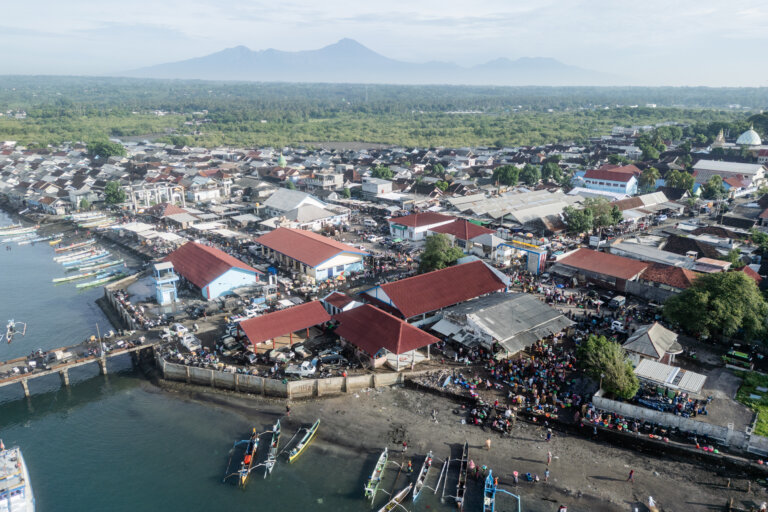
An aerial view of Tanjung Luar, with Mount Rinjani in the background, shows fish being hauled ashore daily in this bustling hub of trade that supports the livelihoods of local fishermen on Lombok Island.
At landing sites, fishermen take turns laying out their catches alongside others to be sold. They typically separate the shark fins from the bodies, selling the fins and meat independently. In Tanjung Luar, most fishermen sell shark meat directly to local buyers at the landing site or transport it to nearby markets. When the catch is larger - usually more than three sharks - they tend to sell it to shark meat traders instead.
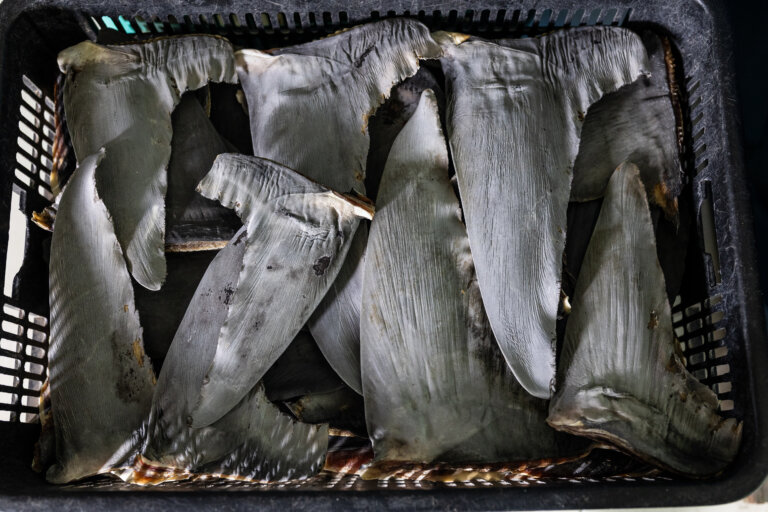
Shark fins are laid out to dry near a traditional market in Tanjung Luar, on the island of Lombok.
"We fishermen here know what is prohibited," said Suparman, one of the collectors in Tanjung Luar. Three types of sharks are prohibited: Manta Rays, Sawfish and Whale Sharks.
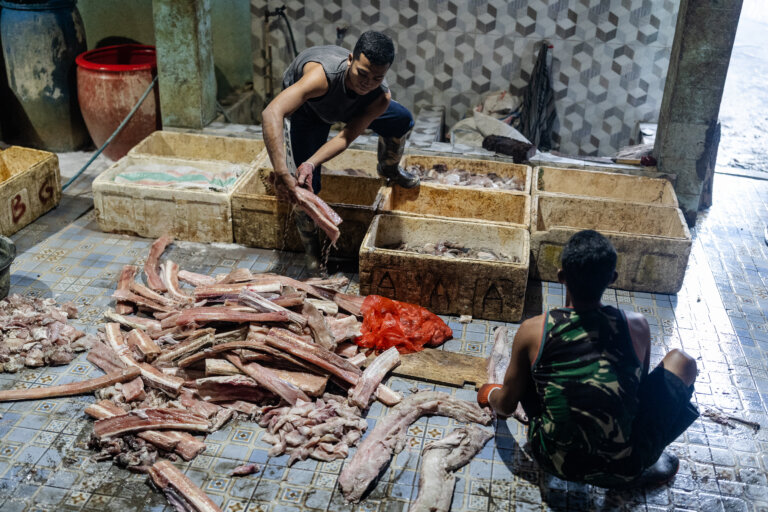
Workers prepare shark meat for cooking at a processing warehouse in Rumbuk Village.
Suparman, who had been a shark collector since 1995, added that if a whale shark was auctioned, he would not want to buy it. "Even if given for free, I would refuse," he said. "The fishermen know the consequences of violating the prohibition."
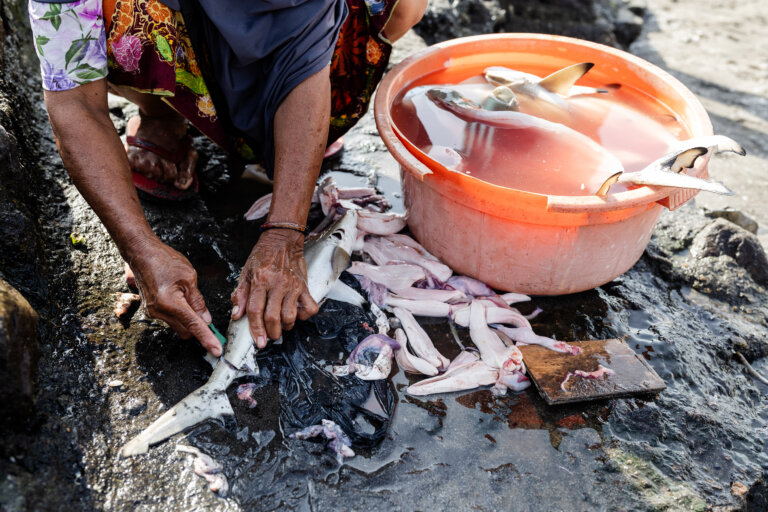
A woman cuts freshly caught baby sharks at a traditional market in Tanjung Luar.
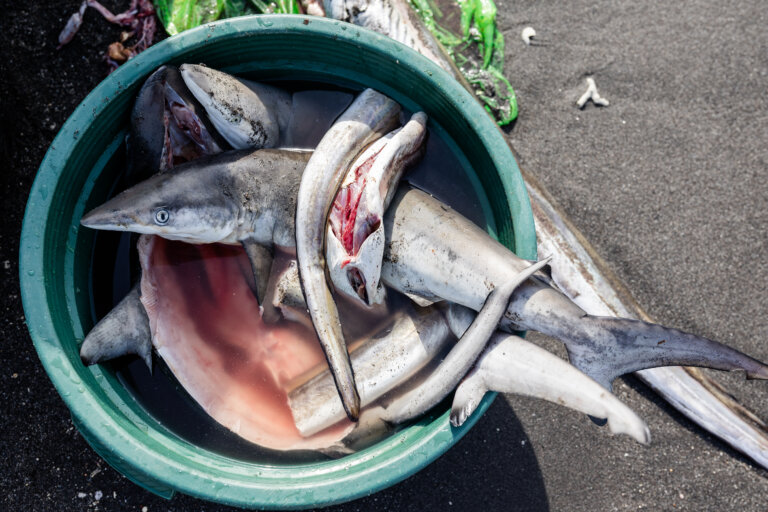
Dead baby sharks lie on the floor of a fish market in Tanjung Luar after being hauled from the hold of a ship, ready for sale.
Long before the ban on whale sharks, Tanjung Luar fishermen believed that they bring good luck and should not be hunted.
When whale sharks appear, it’s a sign the waters are full of small fish. Fishermen often follow in their path, knowing a good catch is likely nearby.
For other types of sharks, as long as they’re not protected and there’s still demand for their fins and meat, fishermen will keep catching them.
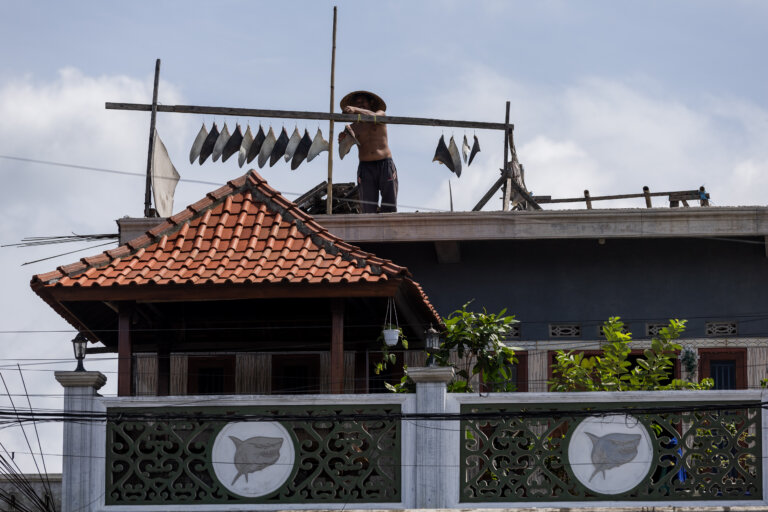
A fisherman drying the fin near a traditional market in Tanjung Luar.
"Fishermen in Tanjung Luar need 15 to 20 days to hunt sharks, [and] the number of catches reaches dozens," said Safruddin, a shark fisherman in Tanjung Luar village, while carrying shark catches from the boat. They Along with 4-5 other fishermen, Safriddin explores the waters of Sumbawa to Sumba in East Nusa Tenggara.
The fishermen sail using wooden boats with 15-30 GT engines. The operational costs of going to sea are relatively high, reaching IDR 15 million [roughly USD 940] per trip. They use both drift longline and bottom longline fishing rods.
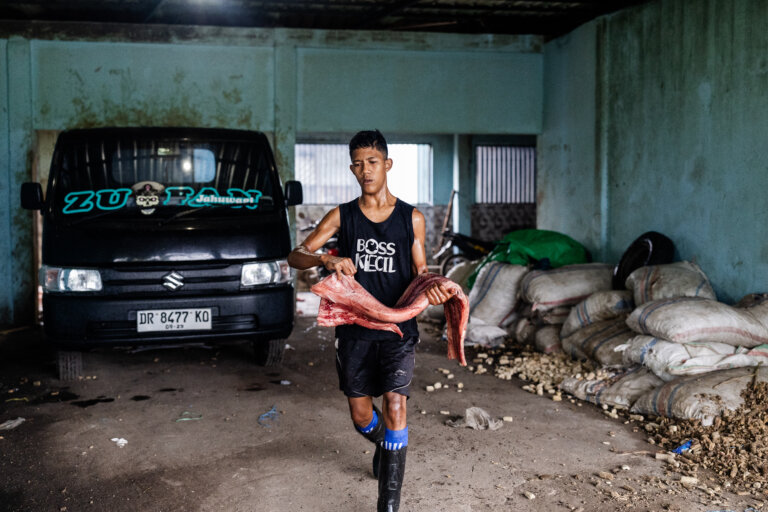
A worker carries a piece of shark meat as it is prepared for cooking at a shark warehouse in Rumbuk.
According to Safruddin, it is difficult to prevent fishermen from catching sharks in East Lombok, "This has been a hereditary job from the previous generation to our generation and this has become a daily livelihood for the people here to make a living and the market price is still promising." The fins, meat, skin, bones, and teeth have a selling value, Safruddin concluded.
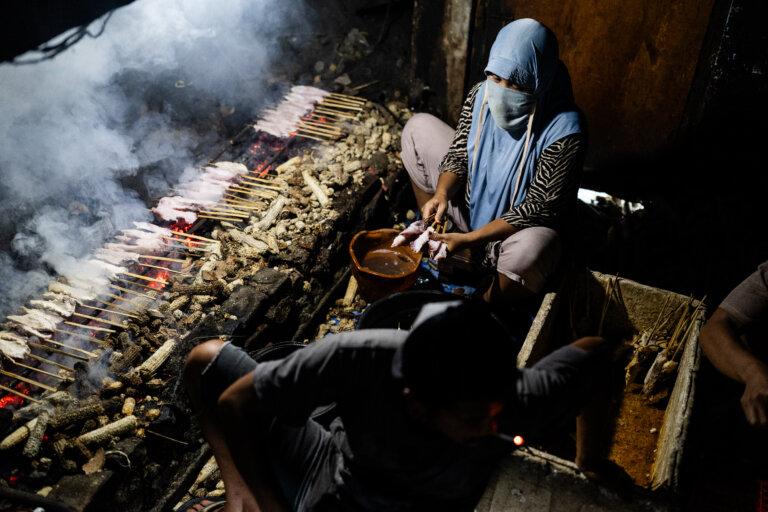
Women grill skewered shark meat for sale at a warehouse in Rumbuk.
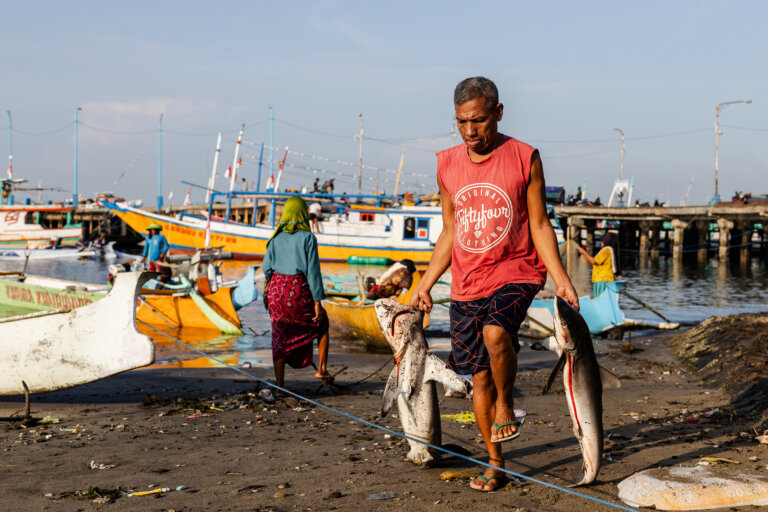
Safruddin carries a fresh-caught shark from a fishing boat at a traditional fish market in Tanjung Luar.
Fishermen in Tanjung Luar Village are only able to catch around 10 to 30 sharks per day, each weighing between 20 and 30 kilogrammes. The sharks are sold at the Tanjung Luar Fish Auction Center (TPI) for IDR 600,000 to IDR 1,000,000 [$37.50 – $62.50] each. These catches fall short of the market demand, which is around 200 sharks per day - a demand that could still be met a decade ago.
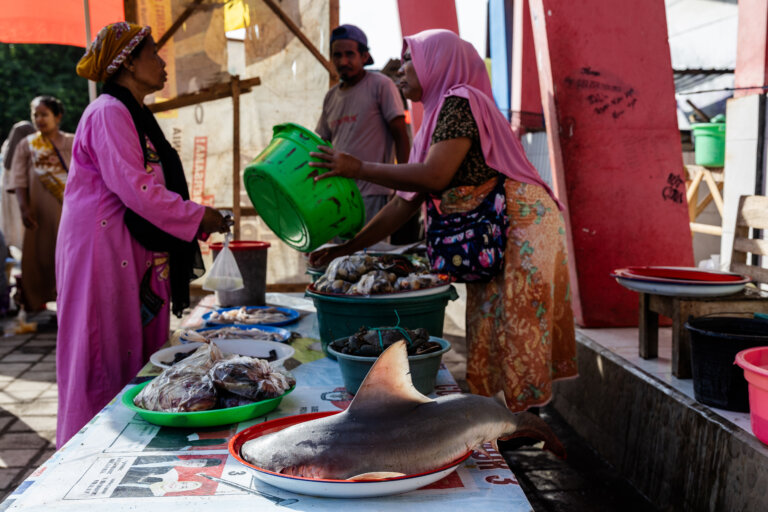
Freshly caught sharks are displayed for sale.
According to a recent study by the World Wildlife Fund (WWF), humans kill an estimated 100 million sharks annually. That's an average of almost 274,000 sharks every day, over 11,000 sharks every hour and around three sharks every second. Often targeted for their fins, this practice affects many different shark species, including whale sharks.
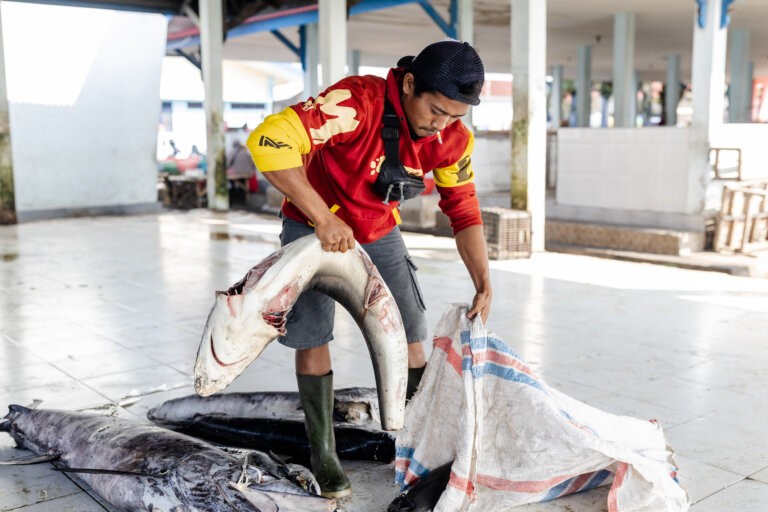
A man loads a shark into a sack at the traditional fish market in Tanjung Luar.
One common method of killing sharks is shark finning - where sharks are caught, their fins are cut off, and the rest of the body is thrown back into the ocean. Unable to swim, the sharks often sink and die a slow, painful death. Shark fins are highly sought after for both their market value and cultural significance. It's estimated that between 23 and 73 million sharks are caught each year for this purpose.
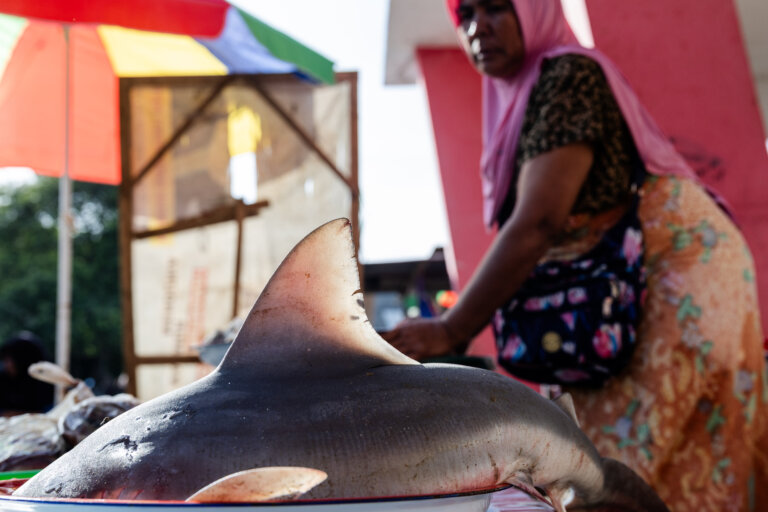
Indonesia has come under international scrutiny for its role in shark exploitation and is considered one of the world’s largest contributors to shark deaths - alongside other tropical countries such as Brazil, Mauritania and Mexico. These nations are either major suppliers of shark meat to global markets or significant domestic consumers.
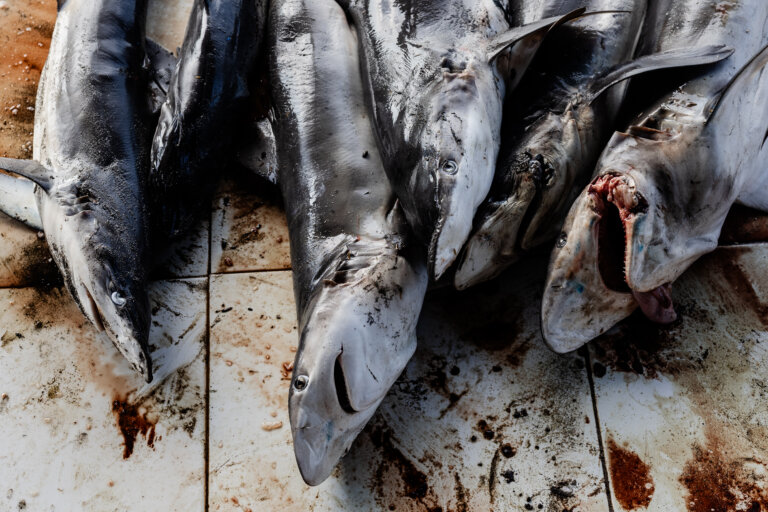
Dead sharks on the ground after being pulled from the hold of a ship, ready to be sold at a traditional fish market in Tanjung Luar, Lombok Island, West Nusa Tenggara,
Every part of the shark's body is sold, but the fins remain the most controversial - and the most valuable. Shark fins can sell for up to IDR 3 million per kilogramme (approximately $187), with smaller quantities of 50 grammes priced between IDR 300,000 and IDR 660,000 ($19–$41). The majority of shark fin exports are sent to countries like China, Thailand, Hong Kong and Japan, primarily through Surabaya, East Java - Indonesia’s second-largest city.
China remains the top export destination for Indonesian shark products, with total exports reaching IDR 626 billion (approx. $39 million) in 2017, followed by Thailand at IDR 356 billion (approx. $22 million). Live sharks are primarily exported to Hong Kong, with 1,098 recorded shipments.
Japan is also a major market. In 2024 alone, more than half of Indonesia’s shark fin exports - valued at USD $1.63 million - were sent to Japan. Over the past five years, Japan has imported over $2 million worth of shark fins from Indonesia, underscoring sustained demand despite growing international calls for shark conservation.
In Chinese culture, shark fins are considered a delicacy and are often believed to have medicinal properties - including claims of being an aphrodisiac and even a cancer cure. Once reserved for the elite, shark fin dishes are now among the most expensive in the world. As China’s middle class has grown, demand has surged, helping to fuel a global trade that continues despite rising conservation concerns.
The shark fin trade in East Lombok is regulated by Indonesia’s Ministry of Marine Affairs and Fisheries (KKP), with implementation overseen by the Coastal and Marine Resources Management Centre (BPSPL). BPSPL is responsible for issuing permits and providing legalisation for traders. In Tanjung Luar, only two shark fin traders currently hold official permits.
As of January 2021, licensing and regulations have improved, with licensed traders working alongside shark fishers to ensure catches comply with government-assigned quotas. Monitoring and enforcement fall under the authority of several agencies, including the Coastal and Marine Resources Management Centre (BPSPL), the Marine Resources and Fisheries Monitoring Agency (PSDKP), and the Fish Quarantine and Quality Control Agency (BKIPM).
Shark bodies were once discarded after the fins were removed, but today local communities turn the meat into food products like meatballs, smoked shark and satay. Its affordability makes shark meat popular, with satay among the most common dishes - typically sold for around 5,000 rupiah (approx. $0.31) per skewer. Processing takes place in Rumbuk Village, Sakra District, East Lombok, and the products are distributed to traditional markets across the region.
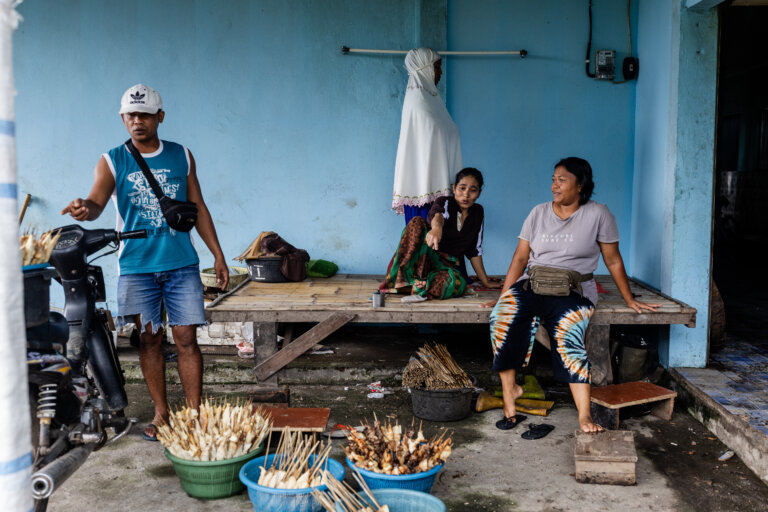
Workers prepare the satay sharks for public consumption at a shark warehouse in Rumbuk village on the Indonesian island of Lombok on 21 February, 2025.
However, studies have shown that shark meat can contain toxic levels of substances such as mercury and ciguatoxin, raising concerns about the health risks associated with its consumption.
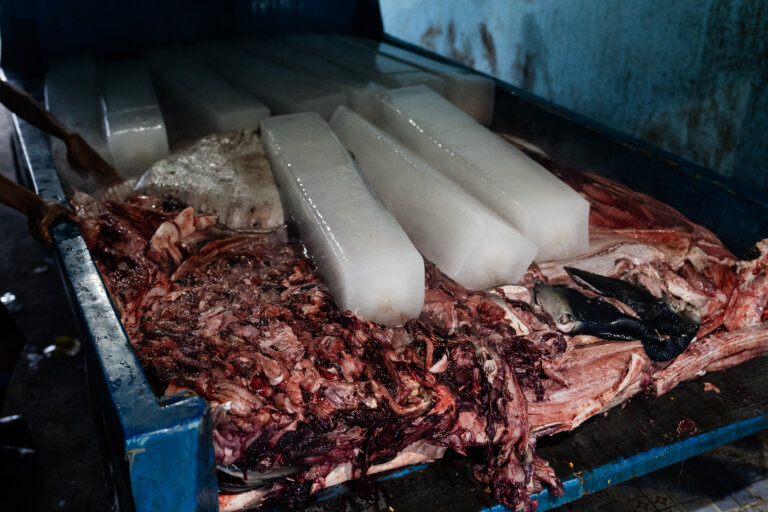
Filleted shark meat sits on a car that has just arrived from the beach at a warehouse in Rumbuk.
Hammerhead sharks (Sphyrna zygaena, Sphyrna lewini, Sphyrna mokarran) and lanceolate sharks (Carcharhinus falciformis) are frequent targets of illegal trade. These species are listed under Appendix II of CITES, which includes animals that are not necessarily threatened with extinction now but may become so unless trade is closely controlled. Continued exploitation without proper regulation puts them at serious risk.

A woman shows a poster of shark species under protection at a traditional market in Tanjung Luar, on the Indonesian island of Lombok on 21 February, 2025.
The Indonesian government regulates the capture and use of sharks and rays through the Minister of Marine Affairs and Fisheries Regulation No. 61 of 2018. This regulation governs the capture, handling and trade of endangered species listed under CITES. Traders are required to obtain a formal recommendation letter for any activity involving the capture, trade or maintenance of these species. Without it, such activities are considered illegal.
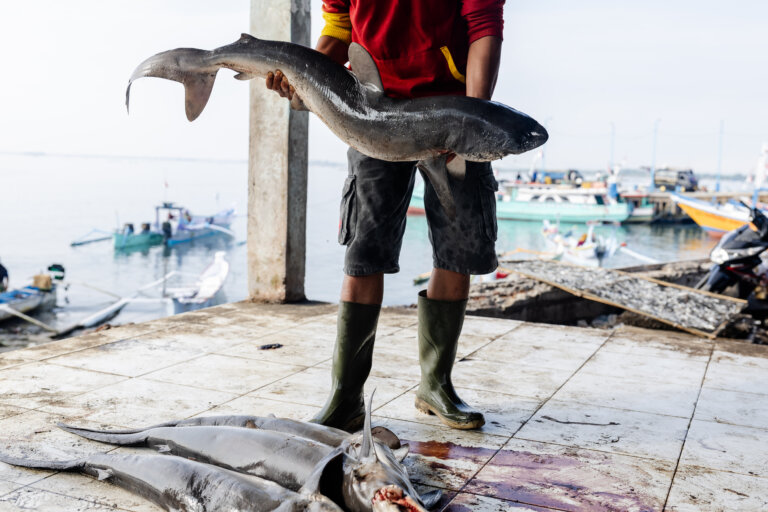
A man carries a freshly caught shark from a fishing boat at the traditional fish market in Tanjung Luar.
According to the latest IUCN report, global demand for shark meat has nearly doubled over the past 20 years since the release of its 2005 assessment. Today, the value of shark and ray meat is approximately 1.7 times greater than that of the global fin trade. The market has also diversified significantly, with products such as ray gill plates, liver oil and shark skins now contributing to an industry worth nearly $1 billion annually.
Sarah Fowler, a scientific advisor from Save Our Seas Foundation, who led the publication of the 2005 report and contributed to this year's version, said, "The conservation and management of sharks is difficult for a variety of reasons, but many governments are breaking down the silos that separate how we deal with sharks and rays as a fisheries resource and as wildlife to be conserved."
Overfishing is pushing many shark species toward extinction, with Indonesia, Spain, and India ranking as the world’s top shark-fishing nations.
"Almost 20 years after the first report, there have been drastic changes, with sharks and rays now among the most threatened vertebrates on the planet," said Alexandra Morata, Programme Officer of the IUCN Species Survival Commission's Shark Specialist Group.
However, after two decades of research and major policy changes, countries are beginning to develop clear strategies to help governments implement conservation efforts and manage shark fisheries sustainably.

Images by Garry Lotulung.
By copying the embed code below, you agree to adhere to our republishing guidelines.
